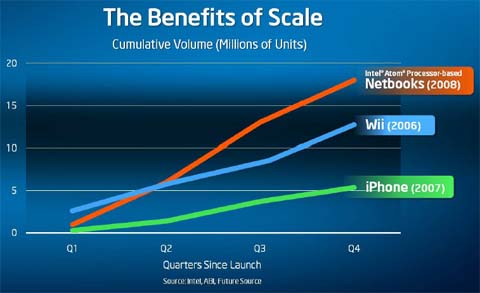Living with a netbook: Toy or tiny notebook?

There is no denying the popularity of netbooks, but there's still much debate about who's buying them and for what purpose. Netbooks were conceived for emerging markets--along the lines of the OLPC's XO laptop and Intel's Classmate PC--but they turned out to be more popular in developed countries. More recently, Intel has downplayed them as "toys" that may complement, but won't cannibalize, real PCs. Still, as netbooks become more capable, it's almost certain that some consumers are choosing them over pricier ultraportables.
Over the past few weeks, I've been trying out five netbooks with 10-inch displays, the Acer Aspire One, HP Mini 2140, Lenovo IdeaPad S10, and Samsung N110 and N120. Some of these have been available for some time; others such as the Samsung N110 and N120 are new. Lenovo just announced an updated IdeaPad S10-2, which is thinner and has a slightly larger keyboard, but has the same basic specs.
I'm not going to write separate reviews of each netbook--most of them have been widely reviewed and I'll include links to some of these. I'm more interested in how netbooks compare to notebooks in real-world use. What's it like to use them for extended periods? How much performance do you give up? And what features are missing? Over the next couple of days, I'll post my thoughts on the design, performance and features of these netbooks.
Though netbooks have only been around for a little more than a year, they've changed drastically since Asus announced the Eee PC in June 2007. The original Eee PC had a 7-inch display, a low-voltage Intel Celeron M processor, 512MB of memory, 2GB of flash storage and Linux. Asus planned to sell it for $199, but the final version ended up costing significantly more.
Nowadays nearly all netbooks use Intel's 1.6GHz Atom N270 paired with Intel's 945GSE Express Chipset with integrated graphics. Some notable exceptions include the Samsung NC20, the only netbook from a major computer company that uses Via's Nano chip, and the Sony VAIO P series and Dell Inspiron Mini 10, which use Atom Z-series chips (this week Dell released an updated Mini 10 with the Atom N270). Most netbooks come 1GB of memory and the tiny SSDs have been replaced by more practical 120- or 160GB hard drives.
While Linux is still an option on many netbooks, the market has settled on Windows (Microsoft says more than 96 percent of netbooks now use Windows). There are a couple of reasons for this. First, customers had trouble adjusting to Linux and return rates were high. Second, when Microsoft realized Vista was a poor fit for netbooks, it dusted off Windows XP and made it available at a very low price--as low as $15 according to one report--eliminating one of the big advantages of Linux.
All of these changes have resulted in netbooks that look and act a lot more like notebooks than the original Eee PC. The large displays have sufficient resolution to properly display Web pages and productivity applications. The keyboards are nearly full-size and most companies have done away with the tiny, odd-shaped keys that made them frustrating to use. The hard drives provide room for most digital photo and music collections. And Windows XP is compatible with most software and peripherals.
Not surprisingly, sales of netbooks have grown fast. Here's a slide from Intel CEO Paul Otellini's presentation yesterday at the company's annual Investor Meeting that puts netbook growth in perspective:
But just because a netbook looks like a notebook, doesn't mean it performs like one. Even when compared to relatively inexpensive laptops, netbooks pale in terms of performance. For example, Excel tasks that typically took 30 seconds to about 1 minute on the mainstream HP Pavilion dv6t took 2.5 to 3.5 times longer on the netbooks. (The dv6t starts at $650 with a 16-inch display, 2.0GHz Core2 Duo T6400, 2GB, Intel GMA 4500MHD and 160GB hard drive.) Even the HP Pavilion dv3z, a 13-inch thin-and-light that costs about $730 with a 2.3GHz AMD Turion X2, finished these tasks in about half the time.
The differences are even more dramatic when multi-tasking, and highly-intensive tasks such as huge spreadsheets, HD video playback and video editing, and 3D gaming are not feasible at all. Incidentally there's virtually no difference in performance among netbooks, which is what you'd expect since they share the same components. I'll post more details on my test results separately. The point is that netbooks are fine for basic communications and productivity tasks, but there's a real difference in performance versus a true notebook.
Though most netbooks share the same specs and performance today, that will soon change. Intel will reportedly release a new Atom processor and chipset in September. Acer, HP, Dell and others are experimenting with netbooks based on ARM processors using Linux-based operating systems such as Google's Android. Despite Intel's insistence that netbooks have 10-inch or smaller displays, Dell already sells a 12-inch netbook, and Acer and Asus have plans to offer 11.6-inch models. These will compete with new, low-cost 12- and 13-inch laptops using AMD's Athlon Neo or Intel's CULV (Consumer Ultra Low-Voltage) chips. Finally, before year-end, Microsoft will release Windows 7, which includes a version for netbooks. The result of all of this will be more choice in terms of price, features and performance in both netbooks and ultraportables in the second half of this year.
